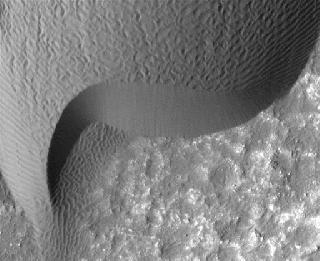
This undated image provided by NASA shows a rippled dune, front, in Herschel Crater on Mars that moved an average of about two yards between March 3, 2007 and December 1, 2010. Photo: NASA.
WASHINGTON (PTI): For the first time, scientists have discovered shifting sand dunes and ripples all over Mars, a finding which suggests strong winds keep the sandy surface of the Red planet much more active than ever imagined.
Images captured by NASA spacecraft Mars Reconnaissance Orbiter showed that wind-blown sand dunes moving across the Martian surface, sometimes up to several yards at a time, the scientists said.
"Mars either has more gusts of wind than we knew about before, or the winds are capable of transporting more sand," lead researcher Nathan Bridges, a planetary scientist at the Applied Physics Laboratory of Johns Hopkins University in the US, said.
"We used to think of the sand on Mars as relatively immobile, so these new observations are changing our whole perspective," Bridges was quoted as saying by SPACE.com.
Scientists have long known that the red dust on Mars can swirl and blow about in many ways, ranging from vast dust storms to small whirlwinds, called dust devils. But less than 10 years ago, astronomers still thought the Martian dunes and sand ripples were either immobile or moved too minutely to ever see.
According to the scientists, who detailed their findings in the journal Geology, the dark sand grains of Mars are harder to move than those of Earth's deserts and beaches because they are larger, and because the Martian atmosphere is thinner than Earth's.
Wind tunnel tests have shown that 130 kmph gusts are required on Mars to move a single a patch of sand, while on Earth, the winds about 16 kmph can achieve the same feat.
But such high wind speeds on Mars are relatively rare, according to observations from NASA's Viking landers collected in the 1970s and 1980s.
The first clues of the Red Planet's moving sand dunes came from NASA's Mars Global Surveyor. More evidence was found by NASA's Mars Exploration Rovers which detected shifting sand when they touched down on the surface of Mars in 2004.
"Sand moves by hopping from place to place," said Matthew Golombek, co-author of the study and a member of the Mars Exploration Rover and Mars Reconnaissance Orbiter teams at NASA's Jet Propulsion Laboratory in Pasadena. "Before rovers landed on Mars, we had no clear evidence of sand moving."
But the researchers also saw several areas where the sand dunes did not move, which indicates that not all of the sand on Mars blows in the wind.
"The sand dunes where we didn't see movement today could have larger grains, or perhaps their surface layers are cemented together," said Bridges. "These studies show the benefit of long-term monitoring at high resolution."
It could be that the areas that seem stationary just take longer to move, which could be triggered by climate cycles on Mars that last thousands of years, the researchers said.
According to them, Mars may once have been warm enough for the carbon dioxide that is now frozen in the polar ice caps to freely form a thicker atmosphere, and the resulting stronger winds could have been responsible for transporting sand.
 Previous Article
Previous Article Next Article
Next Article













The Indian Air Force, in its flight trials evaluation report submitted before the Defence Ministry l..
view articleAn insight into the Medium Multi-Role Combat Aircraft competition...
view articleSky enthusiasts can now spot the International Space Station (ISS) commanded by Indian-American astr..
view article